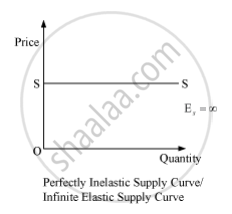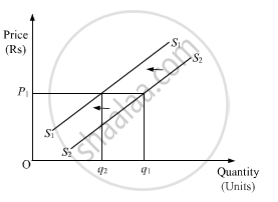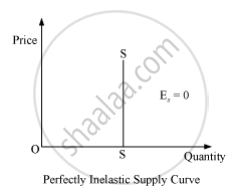Advertisements
Advertisements
Question
Match the following:
| Group A | Group B |
| 1) Perfectly Elastic Supply | a. Vertical supply curve |
| 2) Stock | b. Horizontal supply curve |
| 3) Increase in supply | c. Potential supply |
| 4) Perfectly Inelastic supply | d. Rightward shift in supply curve |
| 5) `"TC"/"TQ"` | e. Leftward shift in |
| f. Average cost |
Solution
| Group A | Group B |
| i. Perfectly Elastic Supply | b. Horizontal supply curve |
| ii. Stock | c. Potential supply |
| iii. Increase in supply | d. Rightward shift in supply curve |
| iv. Perfectly Inelastic supply | a. Vertical supply curve |
| v. `"TC"/"TQ"` | f. Average cost |
Explanations:
i. Perfectly elastic supply implies a situation where the quantity supplied is fully (or highly) responsive to the change in the price of the good. Accordingly, a very small change in the price leads to an infinite change in the quantity supplied. A perfectly elastic supply curve originates from the vertical intercept of the price-axis and remains horizontally parallel to the quantity axis.

ii. Stock is the amount of goods that are available with the seller for sale at a given point of time. A higher stock implies higher sale can be done and vice- versa. Thus, we can say that stock determines the potential supply.
iii. Increase in supply implies that a larger quantity is supplied at the same price. This increase in supply can be because of favourable changes in factors such as decrease in the factor prices, advancement in technology, favourable government policies etc. An increase in supply is represented by a parallel rightward shift of the supply curve.

iv. When the quantity supplied is totally unresponsive to the change in the price of a good, the supply of the good is said to be perfectly inelastic. In such a situation, the supply curve originates from the horizontal intercept of the quantity-axis and remains vertically parallel to the price axis representing that the supply remains fixed whatever be the price.
The figure given below shows a perfectly inelastic supply curve.

v. Average cost is defined as the per unit cost of producing output. It is derived by dividing total cost by quantity of the output produced. That is,
Average cost = `"TC"/"TQ"`
APPEARS IN
RELATED QUESTIONS
Relatively elastic supply
Price is the only determinant of supply.
Elasticity of supply
A producer supplies 80 units of a good at a price of Rs 10 per unit. Price elasticity of supply is 4. How much will he supply at Rs 9 per unit?
When price of a commodity falls from Rs 12 per unit to Rs 9 per unit, the producer supplies 75 percent less output. Calculate price elasticity of supply.
When price of a good rises from Rs 10 to Rs 12 per unit the producer supplies 10 percent more. Calculate price elasticity of supply.
What is perfectly elastic supply?
When price falls by Rs 2 per unit, supply falls from 100 units to 80 units. Price elasticity of supply is 2. What was the price per unit before change?Calculate.
Price elasticity of supply of a good is 2. A producer supplies 100 units of a good at a price of Rs 20 per unit. At what price will he supply 80 units?
When price of a good raises from Rs 12 per unit to Rs 15 per unit the producer supplies 50 per cent more output. What is the price elasticity of supply? Calculate.
When price of a good falls from Rs 20 to Rs 10 per unit, producer reduces supply from 100 units to 50 units. Calculate price elasticity of supply.
A producer supplies 100 units of a good at a price of Rs 20 per unit. Price elasticity of supply is 2. At what price will he supply 50 units? Calculate
When the price of a commodity changes from Rs 4 per unit to Rs 5 per unit, its market supply rises from 100 units to 120 units. Calculate the price elasticity of supply. Is supply elastic? Given reason
Explain the effect of technological progress on supply of a good.
Supply is inversely related to price.
Supply is directly related to price.
Explain, with reason, whether you Agree or Disagree with the following statement
There is no difference between stock and supply.
Give one reason for an “increase” in supply of a commodity.
A firm supplies 10 units of a good at a price of Rs 5 per unit. Price elasticity of supply is 1.25. What quantity will the firm supply at a price of Rs 7 per unit?
State the components of supply of money.
State whether the following statement is true or false :
Supply of perishable goods is inelastic.
Give reason or explain the following statement:
The supply of agriculture commodity is relatively inelastic.
Give reason or explain the following statement:
A monopolist can control the supply of goods .
Give reason or explain the following statement:
The supply of land is inelastic .
Fill in the blank using proper alternative given in the bracket:
Other factors remaining constant, when price of a commodity raises there is ................. of supply.
Give reason or explain the following.
Supply is directly related to price.
Explain with reason, whether you agree or disagree with the following statement:
There is direct relationship between price and quantity supplied.
State whether the following statements are True or False:
Better transport facility increases supply at the same price.
Define or explain the following concepts (Any THREE):
Stock
Fill in the blank with appropriate alternatives given in the bracket:
________ is one of the determinants of aggregate supply.
Fill in the blank with appropriate alternative given below
When the price rises, there is __________ of supply.
Fill in the blank with appropriate alternative given below
The vertical supply curve represents _____________ elasticity.
Fill in the blank with appropriate alternative given below
An increase in supply means selling a ____________ amount at the same price.
State whether the following statement is TRUE and FALSE.
If price falls, the supply curve will shift to left.
State whether the following statement is TRUE and FALSE.
Geometric Method is also known as Point Method.
State whether the following statement is TRUE and FALSE.
Total Cost is the total expenditure incurred by a firm.
Define or explain the following concept:
Total Cost
Define or explain the following concept:
Stock
Define or explain the following concept:
Output
Define or explain the following concept:
Elasticity of Supply
Give reason or explain:
With a slight change in the price, if supply varies in a greater proportion then supply is said to be relatively elastic.
Give reason or explain:
Stock can exceed supply.
Give reason or explain:
When price rises, supply expands.
Write short note on the following:
Elasticity of supply.
Answer the following question:
What are the exceptions to the law of supply?
Do you agree or disagree with the following statement? Give reason.
There is no difference between stock and supply.
Do you agree or disagree with the following statement? Give reason.
Price is the only determinant of supply.
Answer the following about 200 to 250 words
What are the assumptions law of supply?
Answer the following about 200 to 250 words
State and explain the law of supply. What are the exceptions to this law?
Answer the following about 200 to 250 words
Explain various types of Price elasticity of Supply.
Answer the following about 200 to 250 words
Explain various methods to measure Price Elasticity of Supply.
Observe the following table and answer the questions:
Supply schedule of chocolates
| Price in ₹ | Quantity supplied in units |
| 10 | 200 |
| 15 | ______ |
| 20 | 300 |
| 25 | 350 |
| 30 | ______ |
| 35 | ______ |
| 40 | ______ |
- Complete the above supply schedule.
- Draw a diagram for the above supply schedule.
- State the relationship between price and quantity supplied.
Identify & explain the concept from the given illustration.
Amar sells 50 dozens of mangoes daily at ₹ 300/- per dozen.
Identify & explain the concept from the given illustration.
Ajay’s papad and pickle producing unit incurred expenditure of ₹ 50,000/- on machinery, ₹ 1,00,000/- towards rent and ₹ 2,00,000/- on wages for the workers during 2018-19.
State and explain the law of supply.
